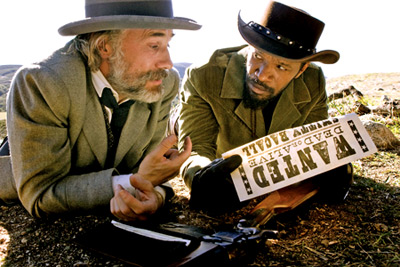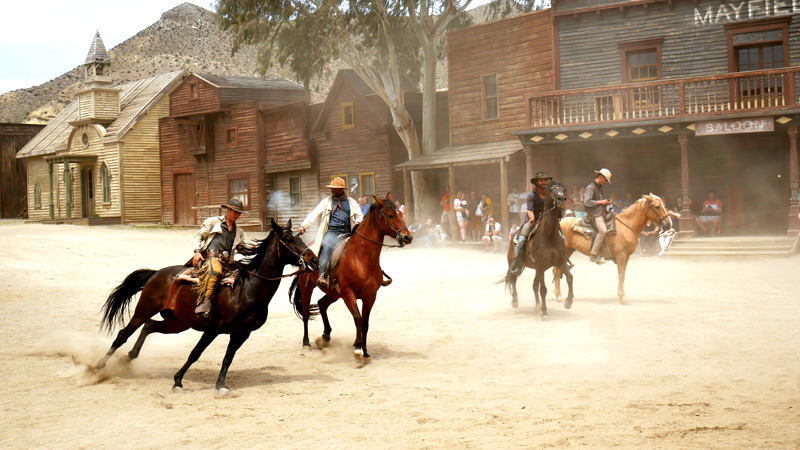The Western, is a genre of film, television, and literature deeply rooted in the cultural fabric of America romanticizing the Old West era of American history.
 These stories generally offered its audiences a look into the culture of that period, while telling entertaining stories of gunslinging heroes, dramatic morality, frontier justice, tense action and more. At its peak, Westerns dominated the Hollywood film industry, with more than 50 films being produced each year, and dozens of TV shows running concurrently.
These stories generally offered its audiences a look into the culture of that period, while telling entertaining stories of gunslinging heroes, dramatic morality, frontier justice, tense action and more. At its peak, Westerns dominated the Hollywood film industry, with more than 50 films being produced each year, and dozens of TV shows running concurrently.
Comparisons have inevitably been drawn between the ubiquity of Westerns in its heyday and the superhero film genre of today. However, this is severely misunderstanding the role and reception Westerns have had throughout film history.
The Western genre predates what we today consider to be the classical era of the Western, with roots in the early 19th century dime novels and works of authors like James Fenimore Cooper and his imitators. These early tales were actually contemporary to the Frontier era, but still romanticized the American frontier, portraying embellished stories of real life figures like Billy the Kid, Wild Bill Hickok and Jesse James while they were still active.
Western literature would go on to find mainstream popularity all across Europe as well. By the turn of the century, most of the common tropes that define the genre had already been codified and established in the pop culture of the time.
Transition to film
The genre’s transition to film began in the early 20th century, and much like most of American media, has its roots in Vaudeville. Its Wild West shows capitalized off the popularity of Western novels, and would go on to define many signature elements of Western films. 1903’s “The Great Train Robbery” is often cited as the first Western movie, but many silent films have since been known to predate it to as early as 1899.
By the 1930s, with the advent of sound films, many of the big budget studios abandoned Westerns and it was considered to be a pulp genre. Smaller studios would rapidly churn out low budget Western films and TV shows, and while they remained ubiquitous, they weren’t popular or commercially successful. This was until the genre’s revival in the 40s and 50s, which is considered today to be the Golden Age of Westerns.
During this period, the genre dominated Hollywood, producing iconic actors like John Wayne, Gary Cooper, and James Stewart who became synonymous with the genre. John Ford’s “Stagecoach” (1939) and Howard Hawks’ “Red River” (1948) are notable examples of Westerns that achieved both critical and commercial success.
 By the 1960s, the traditional Western began to wane in popularity. However, this decline gave rise to a new subgenre known as the revisionist Western which was considered to have a more nuanced depiction of the American frontier.
By the 1960s, the traditional Western began to wane in popularity. However, this decline gave rise to a new subgenre known as the revisionist Western which was considered to have a more nuanced depiction of the American frontier.
Oppression of minorities
Though this was by no means new to the genre, revisionist era Westerns were thought to deconstruct common Western tropes and be more “realistic” than the “romanticization” of the classic era. Films such as ‘Blazing Saddles’ (1974) would also lampoon the Western genre, highlighting some of the realities of that historical period, such as the brutal oppression of minorities, that is usually ignored by most other works in the genre.
Sergio Leone’s Spaghetti Westerns, including the “Dollars Trilogy” starring Clint Eastwood, also emerged during this period.
These films, considered to be cheap at the time, though later vindicated by history, were characterized by their stylized violence and gritty realism.
In recent decades, Westerns have largely declined in popularity. However, some films such as “No Country for Old Men” (2007), Django Unchained (2012), TV shows like “Westworld” (2016) and even games such as “Red Dead Redemption” have managed to find some mainstream popularity by blending with other genres and exploring contemporary themes.






